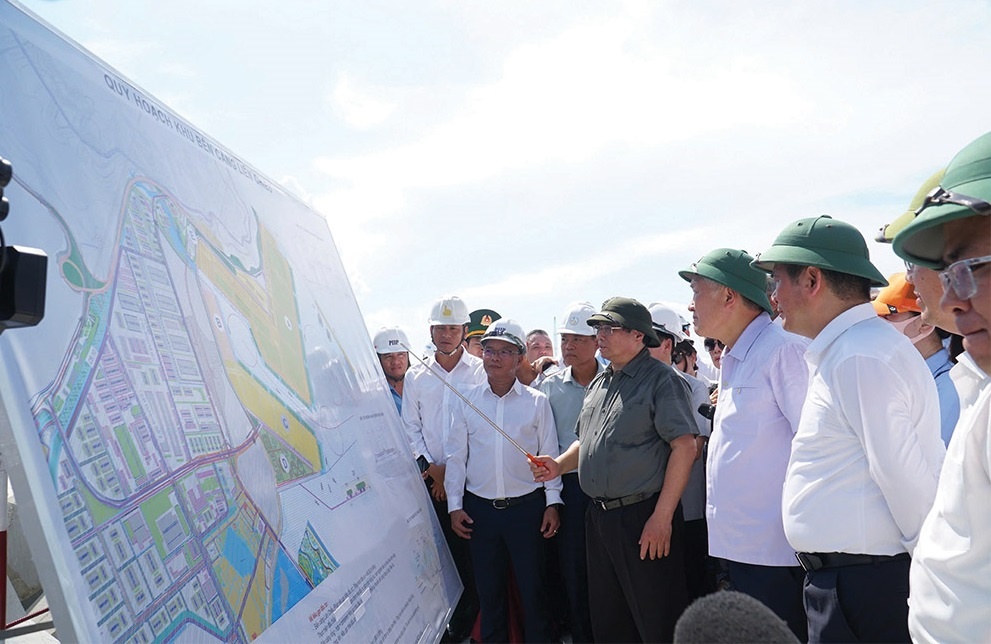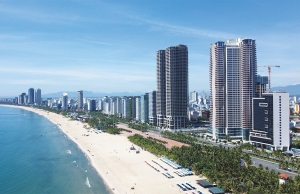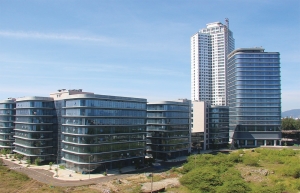Danang pinpoints areas to unleash economic potential
The Danang Statistics Office in late October announced the socioeconomic situation of the city in the third quarter and first nine months of 2024. Regional GDP for the city in the third quarter of 2024 is estimated to have increased by 8.6 per cent over the same period in 2023. In the first nine months of 2024, Danang’s GDP is estimated to increase by 6.47 per cent on-year.
 |
| The city’s planning for the long term is well underway through a series of strategies |
Notably, investment and construction activities in Danang are bustling, especially in the area with non-state investment capital.
Statistics show that in the first nine months of 2024, the total realised development investment capital in Danang is estimated to have reached nearly $1 billion, an increase of 7.1 per cent over the same period.
The municipal government is expecting new impetuses based on its actions. Danang People’s Committee will organise several meetings with the provincial departments and agencies to discuss solutions and plans to develop the city into a high-quality industrial and service hub of the country.
This follows the approval earlier this year of a resolution to promote urban governance and endorse the trial of various policies specifically designed to support Danang’s growth and development.
For the first time in the country, this resolution includes approval for Danang to pilot a free trade zone (FTZ) – a widely used economic model internationally recognised for its potential to drive economic development. This decision is expected to serve as a major catalyst in Danang’s efforts to enhance regional competitiveness, stimulate trade, and attract foreign investment.
Nguyen Van Quang, Secretary of Danang Party Committee, described the approval as a landmark policy decision, calling it a powerful push that will enable Danang’s economy, as well as the broader region, to reach new heights of growth.
“The FTZ pilot represents a bold and innovative approach, as it involves testing a well-established global model in a Vietnamese context where it has no precedent,” Quang said. “While we recognise the potential risks associated with this endeavour, we are committed to pursuing it. If successful, the FTZ could pave the way for similar initiatives across Vietnam, but for now, Danang is prepared to assume any risks.”
Tran Chi Cuong, Vice Chairman of Danang People’s Committee, underscored that the FTZ pilot will create a legal framework that allows Danang to leverage its unique strengths and realise its potential more fully.
“This is of exceptional importance, providing critical and innovative solutions,” Cuong noted. “It addresses longstanding obstacles, unleashing resources and creating a foundation for further growth. This step will allow us to accelerate Danang’s socioeconomic development, unlocking opportunities and addressing persistent barriers that have previously hindered progress.”
Cuong emphasised that the central government’s approval to pilot the FTZ is a crucial part of these new policies. While Vietnam currently lacks legal frameworks for FTZs, these zones are operated in roughly 150 countries worldwide, each implementing competitive mechanisms to stimulate growth and attract investment. By learning from these successful international models, Danang aims to harness its strategic location, resources, and human capital in an FTZ that meets Vietnam’s development needs.
Phung Phu Phong, director of Danang’s Department of Construction, pointed out that FTZ models have been successfully implemented in neighbouring nations such as China and several Arab countries. However, as Vietnam has yet to develop a legal framework to regulate them, Danang now stands as the country’s first locality to pursue this model, potentially creating a new pathway for economic and urban development.
“The FTZ in Danang will feature export processing, logistics, trade and services, and duty-free business,” Phong explained. Unlike conventional FTZs, Danang’s model will not be limited by enclosed boundaries due to the city’s limited land resources. Instead, the FTZ will operate across multiple locations within the city, optimising land use and integrating key infrastructure elements to support growth.
Danang has allocated up to 700 hectares for a dispersed FTZ, which will bring together logistics infrastructure, such as the Lien Chieu seaport, alongside Tien Sa port’s transformation into a dedicated tourist port as part of the FTZ’s development plan.
Examining Danang’s economic potential, Vu Quang Hung, head of the Management Board of Danang High-Tech Park and Industrial Zones, sees the FTZ as a strategic step that will position Danang as an economic powerhouse. Danang’s favourable location – a deep-water seaport, an international airport, coastal borders, and a crucial endpoint along the East-West Economic Corridor – provides an ideal foundation for an FTZ, making it an attractive site for foreign investment.
“The FTZ will facilitate a rapid inflow of capital and technology, reinforcing foreign economic activities and enabling Danang to act as a development engine for neighbouring regions and, ultimately, the nation,” Hung elaborated. “In addition, the FTZ will elevate the value of Vietnam’s tourism and trade by fostering high-end service chains within tourism, retail, and entertainment. This expansion will help attract visitors to Danang and the broader Central Highlands region, further boosting local and national economies.”
Hung added that Danang’s FTZ will be closely integrated with both Lien Chieu Port and Danang International Airport. This integration will support the development of production facilities, recycling, processing, assembly, and packaging of import and export goods. The FTZ will establish Danang as an international cargo transit centre, with robust infrastructure to sustain long-term economic activity and growth.
| Danang has proposed several key locations for its free trade zone, covering inland and coastal sites tailored to various economic activities. The vicinity of Lien Chieu seaport and Hoa Hiep Bac ward in Lien Chieu district, each spanning approximately 100 hectares, are designated as primary logistics service areas, supporting transportation and storage. In Hoa Vang district, the largest site within Hoa Lien commune will cover an expansive 400ha. Additionally, a 300-ha zone in the expanded high-tech park within Hoa Ninh commune has also been designated for production activities, contributing to the city’s industrial capacity. Three proposed commercial service sites include a 90-ha area at the foot of Ba Na mountain, the hillside urban area in Hoa Nhon commune, and both sides of Hoang Van Thai Street, which together span over 50ha. Additional logistics sites are planned in Hoa Nhon Industrial Park, covering 200ha, and another site west of Danang Airport, covering 80ha. These logistics-focused sites will further enhance the FTZ’s role in import-export activities and strengthen Danang’s transportation infrastructure. A large-scale sea reclamation project is also planned, spanning 420ha along Nguyen Tat Thanh Street to Danang Bay, a major endeavour that is expected to be undertaken in the future phases of the FTZ’s development. This area will likely add considerable commercial space for high-end services and tourism-related businesses. |
 | Danang stakes claim with first free trade zone plans Danang’s efforts to push up its socioeconomic development and attraction of investment is being fuelled by an initiative to establish a free trade zone in the central city. |
 | Danang creating strengths from digital transformation Danang has identified digital transformation as a new driving force and the key to solving development bottlenecks, and its efforts have been duly rewarded. |
What the stars mean:
★ Poor ★ ★ Promising ★★★ Good ★★★★ Very good ★★★★★ Exceptional
 Tag:
Tag:
Related Contents
Latest News
More News
- Global partnerships key to Vietnam’s IFC development (December 26, 2025 | 16:18)
- Vingroup pulls out of bid to invest in North-South high-speed railway (December 26, 2025 | 11:42)
- Strengthening supply chains through trade promotions and customs reform (December 24, 2025 | 14:00)
- PM orders investment model for North–South high-speed rail (December 22, 2025 | 17:43)
- LS Eco Energy to invest in Vietnam rare earth sector (December 22, 2025 | 17:31)
- Government moves to establish International Financial Centre (December 21, 2025 | 21:00)
- Vietnam's IFC to target global investment flows (December 21, 2025 | 18:00)
- Two national hospitals expand capacity with new facilities (December 20, 2025 | 09:00)
- Ha Tinh breaks ground on major Vingroup industrial and energy projects (December 19, 2025 | 18:24)
- EVN launches major power infrastructure projects nationwide (December 19, 2025 | 18:17)






















 Mobile Version
Mobile Version